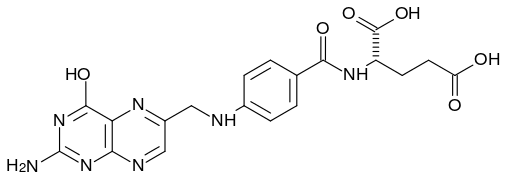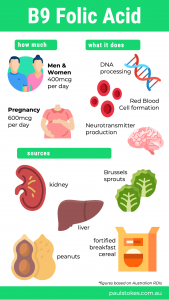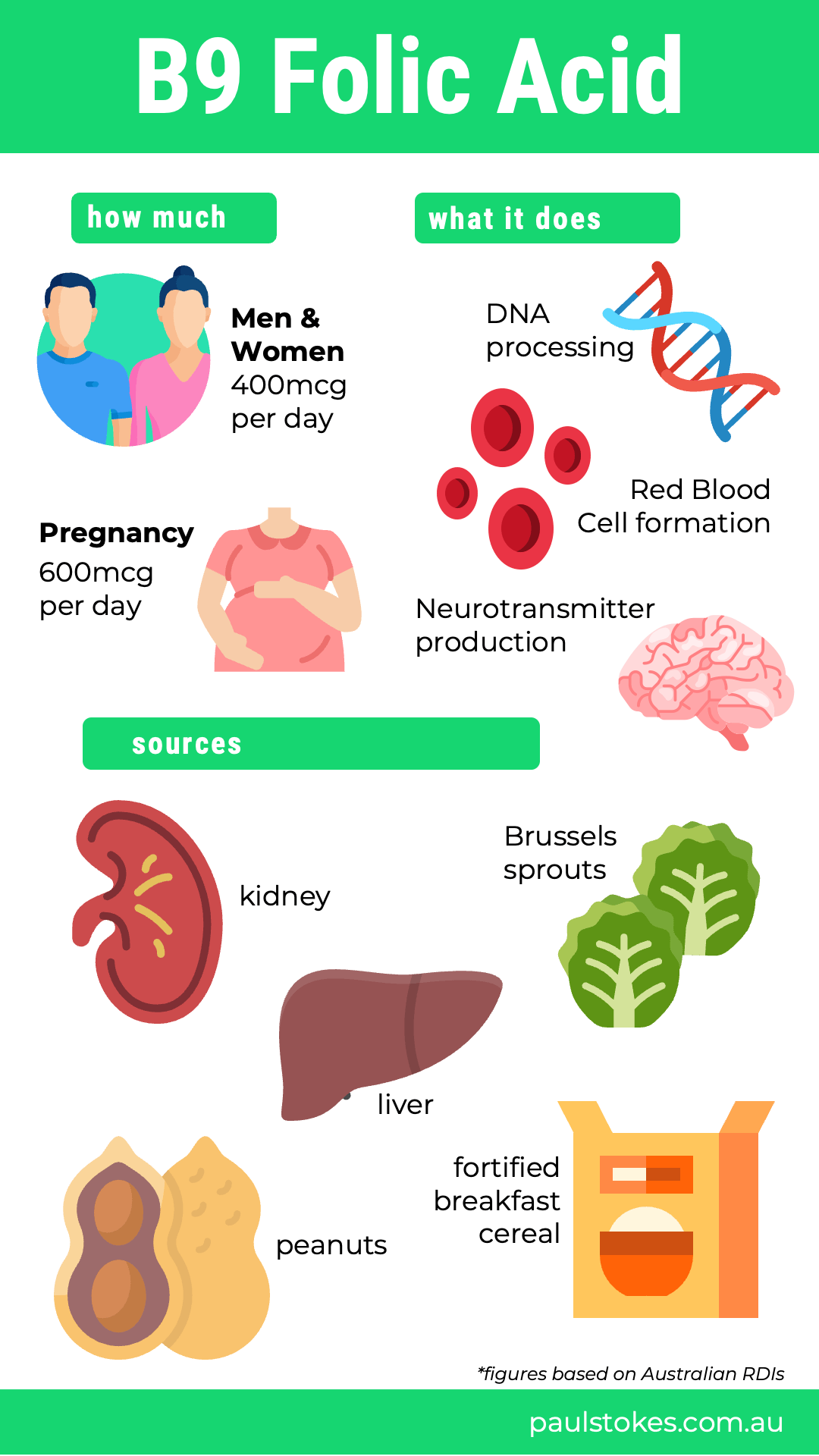Folate seems synonymous with pregnant women. However, folic acid in the foods we eat and how it works in the body have benefits to everyone. We all must consume foods high in folate so we keep fit and healthy. (Are folic acid and folates the same thing?) Read on so you can learn what folic acid does in the body and make sure you get enough.
More...
What is folic acid?
Pure folic acid is a dull yellow non-crystalline substance.
It's slightly soluble in water and heat stable in pH neutral conditions. However, acid destroys its structure as well as light, cooking, and prolonged storage

Chemical structure of Folic Acid. From Wikimedia Commons
Are folic acid and folate the same thing?
Technically, folic acid is the fully oxidised form of folate. Folate is essentially a generic term for naturally occurring food folates, which can have several different structures. These folates are found in a variety of vegetables, as well as fortified products and supplements.
Folic acid can be thought of as a concentrated form of folate. Our bodies convert the folates from the foods we eat into folic acid.
Fun fact
Folic acid was first extracted from spinach leaves in 1941. It was named after the Latin word for leaf, folium.
Its full chemical name (pteroyl glutamic acid) is rarely used, but it is sometimes also referred to as vitamin B9. For practical purposes, vitamin B9, folate and folic acid are all the same.
Although there are several biologically active forms of the vitamin, our body quickly converts them to tetrahydrofolic acid (THFA). This process involves the enzyme NADPH and vitamin C. The activity of NADPH is dependent on vitamin B3 too.
As you can see, folic acid is interlinked with several other pathways and vitamins in our body.
What folic acid does in the body | How folate works
Folic acid plays a pivotal role in proper amino acid metabolism.
It's crucial for proper brain function, particularly the synthesis of neurotransmitter chemicals. These chemicals regulate sleep, pain, and mood.
Therefore, folic acid plays an important role in mental and emotional health.
Folic acid aids in the production of DNA and RNA, the body's genetic material. Folates are especially important during periods of high growth, such as infancy, adolescence, and pregnancy.
Folic acid also works closely together with vitamin B12 to regulate the formation of red blood cells. Additionally, this process helps iron function properly in the body.
How much folic acid do I need?
The UK Reference Nutrient Intake (RNI) figures for folate are 200mcg/day for males and females 11 years and over. For pregnancy, the recommendation is to increase folic acid intake by another 100mcg per day.
In Australia, the current Recommended Dietary Intake (RDI) for males and females is 400mcg per day. However, for pregnancy, recommended folic acid intake increases to 600mcg. Subsequently, it drops to 500mcg during lactation.
In the United States, the Recommended Dietary Allowance (RDAs) are the same as Australia's RDIs.
Why is folic acid important during pregnancy? | Folate and Pregnant Women
Due to its role in brain and DNA development, folate levels are crucially important to a growing foetus. Even a mild shortfall in folic acid can produce irreversible neural tube defects like spina bifida.
Most health professionals recommend all women of child-bearing age, pregnant or not, consume adequate levels of folate. Since many pregnancies are unplanned, these guidelines help avoid problems arising before the woman is aware of her condition.
Foods high in folate | Folic Acid Foods
Good sources of folic acid include:
Also, since folic acid is so important to public health, it's added to fortify refined bread and cereals. This helps to replace folates that may be lost during food processing and manufacture.
Am I getting enough folic acid?
Food | Folic acid Content |
|---|---|
Ox liver (stewed) | 290 |
Blackeye beans (boiled) | 210 |
Fortified breakfast cereal | 180 |
Kidney (ox, stewed) | 130 |
Brussels sprouts | 124 |
Peanuts | 110 |
Broccoli (steamed) | 72 |
Lettuce | 60 |
Almonds | 44 |
Bread (wholemeal) | 40 |
Peas (frozen, boiled) | 31 |
Cheese (cheddar) | 31 |
Eggs (boiled) | 30 |
Bread (white) | 29 |
Oranges | 23 |
Bananas | 9 |
Milk (semi-skimmed) | 9 |
Apples | trace |
*Figures supplied by the UK Government Composition of Foods Integrated Dataset | |
What happens if I don't get enough folic acid?
Again, shortages of folate in pregnant women can cause irreversible birth defects.
However, it's not just women who need to monitor their folate intake.
Since your body works with folic acid in several different ways, it's important for many reasons.
Long-term low folic acid intakes have been linked to a range of conditions. Issues such as irritability, apathy, and certain types of anaemia. Additionally, mental illnesses such as depression and schizophrenia have been exacerbated by low folate levels.
Furthermore, your risk increases for certain types of cancer, Alzheimer's disease, osteoporosis, inflammatory bowel disease and heart disease.
Who should take the most care to regulate folic acid intake?
All women of child-bearing age should make sure they keep up their folate levels. Folic acid requirements obviously increase during pregnancy.
Likewise, dieters who've cut back on food intake should take note. Reducing your food intake can mean you're reducing your intake of vitamins and minerals overall too.
Additionally, if your diet relies on regular junk food and processed foods, it's likely you won't be getting enough.
Certain gastric and digestive diseases mean you can fail to absorb some vitamins and minerals appropriately.
Also, some medications can impair the absorption and uptake of folic acid too. If you're concerned, have a chat with your doctor or dietitian who can advise you on your personal circumstances.
Summary of reasons and causes for folic acid deficiencies
Dietary factors
Poor absorption
Medications and drug interactions
Where requirements are above normal
When your body gets rid of too much folate
READ ALSO: All about vitamin C
Can I get too much folic acid?
Yes. Although folic acid in itself is a relatively non-toxic vitamin, doses above 1000mcg/day can mask or hide an underlying vitamin B12 deficiency.
In fact, a B12 deficiency that remains undiagnosed and untreated can lead to irreversible damage to the nervous system. This is particularly true for the elderly, who tend to find it harder to absorb vitamin B12 from the diet.
The current advice is: taking up to 1000mcg/day of supplemental folic acid is unlikely to be harmful, but this should not be exceeded.
Folic acid and sports performance
There have been a few theories about how folates may help improve fitness and performance. Since folic acid works as a coenzyme when forming DNA and subsequently red blood cells, it's thought that more folates might mean more blood cells. Having more red blood cells available to transport oxygen to working muscles would surely make our muscles work better.
Well, not quite.
A study looked at well-nourished athletes, as well as folate-deficient subjects, and found no difference in performance after folic acid supplementation.
However, in the case of heart disease, folic acid can help.
There's an amino acid, homocysteine, which is used as a marker for heart disease. High levels of homocysteine can contribute to blood clots and damage to your arteries and blood vessels. A 2002 study shows folic acid may help reduces homocysteine levels.
Check out the folic acid (vitamin B9) infographic
If you found the article interesting, feel free to share it via social media. Any questions or feedback? Let me know in the comments section below.
Click the image for the full size version.

This article is part of a series examining different nutrients and our requirements for them. Read other articles in my nutrient spotlight series.

